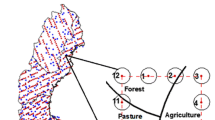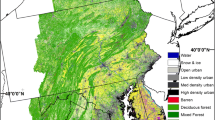Abstract
Digital map of forest dynamics is emerging as a useful research and management tool. As a key issue to address in developing digital maps of forest dynamics, spatial autocorrelation has been distinguished into “true” and “false” gradients. Previous ecological models are mostly focused on either “true” or “false” gradient, and little has been studied to simultaneously account for both gradients in a single model. The main objective of this study was to incorporate both gradients of spatial autocorrelation in a deterministic geospatial model to provide improved accuracy and reliability in future digital maps of forest dynamics. The mapping was based on two underlying assumptions—unit homogeneity and intrinsic stationarity. This study shows that when the factors causing the spatial non-stationarity have been accounted for, forest states could become a stationary process. A prototype geospatial model was developed for the Alaska boreal forest to study current and future stockings across the region. With areas of the highest basal area increment rate projected to cluster along the major rivers and the lowest near the four major urban developments in Alaska, it was hypothesized that moisture limitation and inappropriate human interference were the main factors affecting the stocking rates. These results could be of unprecedented value, especially for the majority of Alaska boreal region where little information is available.









Similar content being viewed by others
References
Akaike H (1974) A new look at the statistical model identification. IEEE Trans Autom Control 19(6):716–723
Bailey TC, Gatrell AC (1995) Interactive spatial data analysis. Longman, Essex
Baird B (2011) Spatial and temporal trends in vegetation index in the Bonanza Creek experimental forest. University of Alaska Fairbanks
Bolstad PV, Swank W, Vose J (1998) Predicting Southern Appalachian overstory vegetation with digital terrain data. Landscape Ecol 13:271–283
Cipar J, Cooley T, Lockwood R, Grigsby P Distinguishing between coniferous and deciduous forests using hyperspectral imagery. In: Geoscience and remote sensing symposium, 2004. IGARSS ‘04. Proceedings. 2004 IEEE international, 2004, vol 4, pp 2348–2351
Congalton RG (1991) A review of assessing the accuracy of classifications of remotely sensed data. Remote Sens Environ 37:35–46
Cressie NAC (1993) Statistics for spatial data. J. Wiley, New York
Department of Community Development M (2008) Forest management plan. Matanuska-Susitna Borough, Palmer, AK, p 14
Gittins R (1968) Trend-surface analysis of ecological data. J Ecol 56(3):845–869
Gorelick R (2006) Combining richness and abundance into a single diversity index using matrix analogues of Shannon’s and Simpson’s indices. Ecography 29(4):525–530
IPCC (2001) Climate change 2001: the scientific basis. In: Houghton JT, Ding Y, Griggs DJ et al (eds) Contribution of Working Group I to the third assessment report of the Intergovernmental Panel on Climate Change. Cambridge University Press, Cambridge, p 881
Johnstone JF, Hollingsworth TN, Chapin FS, Mack MC (2010) Changes in fire regime break the legacy lock on successional trajectories in Alaskan boreal forest. Glob Change Biol 16:1281–1295
Kuuluvainen T, Sprugel DG (1996) Examining age- and altitude-related variation in tree architecture and needle efficiency in Norway spruce using trend surface analysis. For Ecol Manage 88:237–247
Legendre P (1993) Spatial autocorrelation: trouble or new paradigm? Ecology 74(6):1659–1673
Legendre P, Oden NL, Sokal RR, Vaudor A, Kim J (1990) Approximate analysis of variance of spatially autocorrelated regional data. J Classif 7:53–75
Liang J (2010) Dynamics and management of Alaska boreal forest: an all-aged multi-species Matrix growth model. For Ecol Manage 260(4):491–501
Liang J, Zhou M (2010) A geospatial model of forest dynamics with controlled trend surface. Ecol Model 221(19):2339–2352
Liang J, Picard N (2012) Matrix model of forest dynamics: an overview and outlook. For Sci. doi:10.5849/forsci.11-123
Liang J, Buongiorno J, Monserud RA (2005) Growth and yield of all-aged Douglas-fir/western hemlock stands: a Matrix model with stand diversity effects. Can J For Res 35(10):2369–2382
Liang J, Buongiorno J, Monserud RA, Kruger EL, Zhou M (2007) Effects of diversity of tree species and size on forest basal area growth, recruitment, and mortality. For Ecol Manage 243:116–127
Liang J, Zhou M, Verbyla D, Zhang L, Springsteen AL, Malone T (2011) Mapping forest dynamics under climate change: a matrix model. For Ecol Manage 262:2250–2262
Malone T, Liang J, Packee EC (2009) Cooperative Alaska Forest Inventory. Gen. Tech. Rep. PNW-GTR-785, USDA Forest Service. Pacific Northwest Research Station, Portland, p 42
Matheron G (1969) Le krigeage universel. Cahiers du Centre de Morphologie Mathematique. Ecole des Mines de Paris, Fontainebleau
Miller J (2005) Incorporating spatial dependence in predictive vegetation models: residual interpolation methods. Prof Geogr 57(2):169–184
Miller J, Franklin J, Aspinall R (2007) Incorporating spatial dependence in predictive vegetation models. Ecol Model 202:225–242
Mitchell TD, Carter TR, Jones PD, Hulme M, New MG (2004) A comprehensive set of high-resolution grids of monthly climate for Europe and the globe: the observed record (1901–2000) and 16 scenarios (2001–2100) Tyndall Working Paper. Tyndall Centre, Norwich, p 30
Olson DM, Dinerstein E, Wikramanayake ED, Burgess ND, Powell GVN, Underwood EC, D’Amico JA, Itoua I, Strand HE, Morrison JC, Loucks CJ, Allnutt TF, Ricketts TH, Kura Y, Lamoreux JF, Wettengel WW, Hedao P, Kassem KR (2001) Terrestrial ecoregions of the world: a new map of life on earth. Bioscience 51(11):933–938
Pfeffer K, Pebesma E, Burrough P (2003) Mapping alpine vegetation using vegetation observations and topographic attributes. Landscape Ecol 18(8):759–776
Phelps JE (2005) Emerging industry in Alaska’s boreal forests: a hurting timber industry takes on a new edge. Alaska Business Monthly Oct-2005
R Development Core Team (2010) R: A language and environment for statistical computing. R Foundation for Statistical Computing, Vienna
Ribeiro PJ Jr, Diggle PJ (2001) geoR: a package for geostatistical analysis. R-NEWS 1(2):ISSN 1609-3631
Rupp TS (2008) Projected vegetation and fire regime response to future climate change in Alaska. Preliminary Report prepared for U.S. Fish and Wildlife Service National Wildlife Refuge System. University of Alaska Fairbanks, Fairbanks, AK
Scheiter S, Higgins SI (2009) Impacts of climate change on the vegetation of Africa: an adaptive dynamic vegetation modelling approach. Glob Change Biol 15(9):2224–2246
Schwarz G (1978) Estimating the dimension of a model. Ann Stat 6(2):461–464
Shannon CE (1948) A mathematical theory of communication. Bell Syst Tech J 27:379–423
Stage AR, Salas C (2007) Interaction of elevation, aspect, and slope in models of forest species composition and productivity. For Sci 53(4):486–492
Wermelinger B (2004) Ecology and management of the spruce bark beetle Ips typographus-a review of recent research. For Ecol Manage 202(1–3):67–82
Yan X, Shugart HH (2005) FAREAST: a forest gap model to simulate dynamics and patterns of eastern Eurasian forests. J Biogeogr 32:1641–1658
Yarie J (2008) Effects of moisture limitation on tree growth in upland and floodplain forest ecosystems in interior Alaska. For Ecol Manage 256(5):1055–1063
Acknowledgments
The author is obligated to Dr. Dave Verbyla and Randy Peterson for their assistance with spatial analysis and mapping. Bonanza Creek species distribution map is kindly provided by Dr. Dave Verbyla. The author also wants to thank Dr. Mo Zhou, Dr. John Yarie, and Dr. Dave Valentine for their helpful comments. This research is supported in part by the Division of Forestry and Natural Resources, West Virginia University, USDA McIntire-Stennis Act Fund ALK-03-12, and the School of Natural Resources and Agricultural Sciences, University of Alaska Fairbanks.
Author information
Authors and Affiliations
Corresponding author
Rights and permissions
About this article
Cite this article
Liang, J. Mapping large-scale forest dynamics: a geospatial approach. Landscape Ecol 27, 1091–1108 (2012). https://doi.org/10.1007/s10980-012-9767-7
Received:
Accepted:
Published:
Issue Date:
DOI: https://doi.org/10.1007/s10980-012-9767-7




